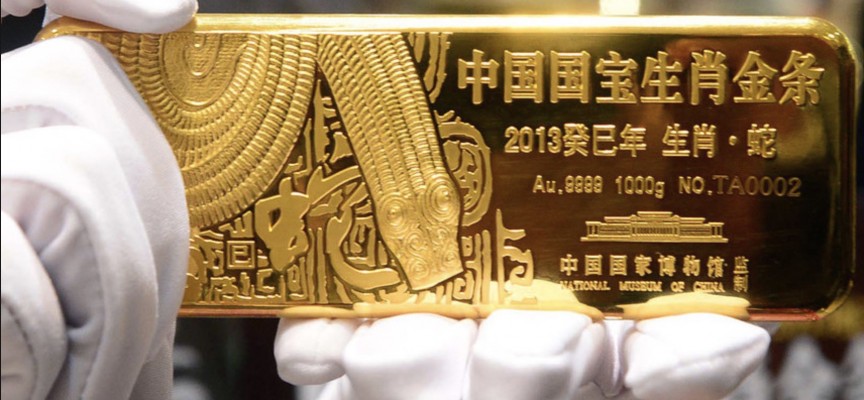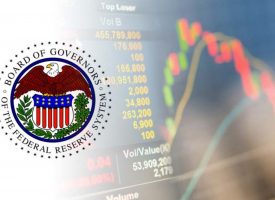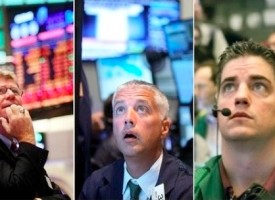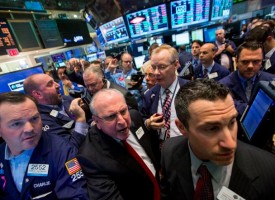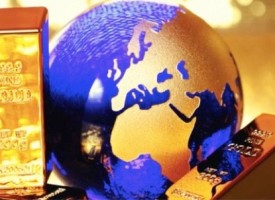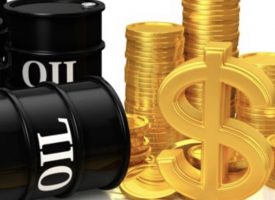With the US dollar tumbling and gold and silver surging, a legend who is connected in China at the highest levels just predicted that the price of gold will skyrocket 75% within 18 months!
8 Years After The Financial Crash
By John Ing, Maison Placements
July 26 (King World News) – Eight years after the global financial crash and despite fears of tightening, stock markets are near historic records. So much liquidity was pumped into the market that investors faced with too much money and not enough opportunities, frantically chased any investment that might produce a return. Markets are addicted to cheap money. However, the Trump bump has turned into the Trump slump as hopes fade for Trump economic stimulus in the wake of his healthcare reform failure. Investors face a darkening picture, particularly when the world’s largest borrower faces another debt-ceiling fight this fall…
IMPORTANT:
To hear which legend just spoke with KWN about $8,000 gold and the coming mania in the
gold, silver, and mining shares markets CLICK HERE OR ON THE IMAGE BELOW.

We believe the global boom in assets has peaked and former economic drivers, like China and Japan are slowing down as they reduce money printing. The European Central Bank (ECB), too is tightening. Creditors, debtors, investors and savers should be on the edge of their seats. Yet markets remain skeptical with the VIX index which measures volatility, at new lows. Part of the reason is that the excess liquidity has provided an illusion of prosperity. Some think that without cheap money, stock prices will fall. Others believe the past era of sub-zero interest rates and cheap credit will end in hyperinflation. Fear of higher interest rates did cause an almost $100 drop in gold on worries that the central banks will empty the punch bowl. Yet, despite tough rhetoric, Yellen has shown her bark is worst than her bite.

End of Cheap Money
Since 2009, the world’s largest central banks have been knee deep in credit creation supporting financial markets by keeping interest rates low and buying trillions of bonds with newly minted money. The tremors are being felt around the world as they remove the props from quantitative easing and crisis-era monetary policies. That prospect alone caused a sell off in global bond markets on fears that trillions of bonds were to be dumped on the market. In 2007, global debt was $149 trillion. After a decade of ultra-loose monetary policies, global debt is higher as a proportion of GDP than in 2007, and driven by households and the non-financial corporate sector, debt is at a whopping $217 trillion. And what of the central banks? Central banks created more than $19 trillion from the thinnest of air, up from $3 trillion in 2000 or a 533 percent increase. The Federal Reserve’s bond portfolio alone grew from $700 million in 2008 to a whopping $4.5 trillion and Chair Yellen promises “normalization”. What ballasts the US monetary system is debt, and it is still growing. Yet, words are not enough. Investors will look at hard facts and to date, bluffing has been a major part of Yellen’s portfolio.
The biggest worry is that America has become the centre of global disorder. The unwinding of quantitative easing requires selling the assets bought in QE back to the markets, difficult when rates are higher and bond prices lower. The sums are huge which could lead to very high inflation. Yet the Fed could always allow its bonds to mature instead of flooding the market. However, some $10 billion of securities would mature each month, rising to $30 billion later on, but would take three to five years for the Fed to reduce the balance sheet by only half. Lost on everyone is that the Fed purchased about 40 percent of the government securities, not only to keep interest rates low but also to finance the federal government’s huge deficits. We are in uncharted territory.
The Fed currently holds about 15 percent of US government debt and a third of its long bonds. Markets are complacent in the belief that the Fed’s move will prove to be painless, ignoring even a flattening of the yield curve. The absence of the Fed will be felt in other ways. The Fed also holds about 25 percent of all mortgage bonds, excluding those held by Fannie Mae. Without the Fed’s presence, rates must increase due to the competition for funds. Rising interest rates would be a new phenomenon. This market has underpriced risk.
US Debt Ceiling Falling Down
The last time Congress enacted a major law was Obama’s healthcare bill, over seven years ago. Since then neither Obama nor Trump has been able to muster enough support to pass any other significant bill. Even though they control the White House as well as both the Senate and the House, the Republicans led by Trump could not undo that piece of legislation. The Trump trade is quickly being unwound. All may be for naught if dysfunctional Washington fails to raise or eliminate the federal debt ceiling, forcing the government to run out of cash this September. The potential for a conflict with the Fed is very real, as well as a sovereign default which would bankrupt the country. Brinksmanship has not disappeared, particularly in the age of Trump and the Fed might have to act as a backstop.
To get the economy going, Candidate Trump promised to deliver sweeping deregulation and tax reform. However today, President Trump’s much vaunted trillion-dollar infrastructure spending plan actually shrunk in half as the trillions of promised spending for bridges, roads and airports was a paltry $200 billion to fund a 10 year private-public partnership, leveraged on a five for one basis using, of course, other people’s money. Important because President Trump’s spending plans will top $4 trillion for the first time in fiscal 2017, at a time when the Fed has promised “tightening”. Of course like healthcare, among the Republicans there are different views and agendas with regard to spending, tax reform and balancing the budget. If the President can’t get make any progress on Obamacare, what will happen with tax reform which is equally divisive, requiring coalition consensus. And, Congress would first have to lift the debt ceiling before they could turn to tax cuts.
Then in this topsy turvy world there is the conservative central banker, Fed Chair Yellen, declaring that she, “doesn’t believe that we will see another crisis in our lifetime”. Can she be believed? Two decades earlier, her predecessor, Alan Greenspan mused about overvalued asset prices reaching unsustainable levels citing “irrational exuberance” in 1996, yet did little to stop the subsequent five-year bubble that burst in 2000. Or there was Ben Bernanke’s assertion that the sub-prime mortgage problem would have minimal effect on the housing sector. He too promised to raise rates and shrink the Fed’s balance sheet. Bad call. Fed chairs don’t get it, progressing from hubris to complacency to delusional. How could they consistently be wrong? Yellen’s term expires in February.
No Country Is An Island
In this topsy-turvy world of the Trump era, his election threatened the old parties, media and America’s allies. As Mr. Trump transforms America, his retreat from the world stage creates a vacuum. The pillars of the postwar order in the West are crumbling, as America destroys the order that it carefully built up amid the ruins of the Second World War. Western alliances no longer can be taken for granted as America cedes global leadership for isolation. The shocking irony is that Mr. Trump’s obsessive “Make America Great” rhetoric is undoing 70 years of American hegemony, dismantling the global architecture that saw US national interests embedded in the international economic and financial system. German Chancellor Merkel is not one to sugarcoat. She already questions whether Germans can depend on the US or UK as allies. Instead of the “Art of the Deal”, Mr. Trump should have written, “How to Win Friends and Influence People”.
Meantime, emboldened Gulf States have begun a proxy war with Qatar which splits the Middle East into warring camps and probably would not have been done, were it not for America’s isolation. The economic embargo is more than a skirmish within “the family” since Qatar sought rapprochement with Iran as this regional conflict is set to spread. Ironically, North Korea’s Kim Jong Un firing of a missile has done more than Trump, in uniting the big powers.
So in this “topsy-turvy” world, the status quo no longer remains.
The Shoe Is On The Other Foot
America’s retreat from the world stage, has galvanized China which has taken major steps to extend its influence. In stepping into the breach, President Xi Jinping’s “China Dream” of recreating the one thousand year-old Silk Road linking Asia, Europe and Africa is a major step into the vacuum created by America’s new isolation. Ironically Xi’s “One Belt, One Road” plan emulates the US led Marshall Plan that revived Europe and cemented America’s supremacy. And despite an earlier bromance between Trump and Xi, the administration is again threatening to impose tariffs on steel and other imports. The markets were warned but nobody seems to be listening.
Meantime China has extended its global supply chain and influence. Chinese stocks hit an 18 month high after MSCI included China in its global benchmark equity index for the first time ever. The move reflects that Chinese equity and bond markets are now the second and third largest in the world respectively, putting China on every global investors’ map. China also saves half of its annual output. And despite a domestic crackdown, it has major overseas deal-making enterprises reflecting a state-led capitalism push. In fact, China is the world’s largest creditor. For some time, America was China’s biggest market. No longer does China need to rely on it because Asia, Europe and the Middle East are larger. But the biggest transformation is that the US may need China more, for finance – the shoe is on the other foot.
Buy or Sell?
We are concerned about the markets’ growing complacency of ignoring the Washington circus or even the prospect of higher rates. Commentators focus on “baiter-in-chief” Trump’s minutia and little on fundamentals such as market risk, infrastructure spending, taxation or even health spending. The longer the market rises, the more complacent its participants become. History shows that only the cynics and the paranoid can survive. Through the lens of conventional deliberation, investors today have taken on too much risk, ignoring the boom-bust cycles of the last half century. Policymakers too have displayed fast and loose thinking, believing that the stock market daily highs are an endorsement of their policies. That today’s prosperity is due to the taking on of more debt, is lost on them. The media too is more obsessed over fake news than fundamental reporting. We believe the market and the comeuppance is part of the increasing populism born out of the legacy of the debt crisis. The downside will only be felt when the politicians and policymakers have been found to be without clothes.
There are also technical reasons for the market’s overvaluation. Algorithms and the introduction of indexed ETFs is one reason for the high valuation as funds self-reinforce the trend. For example, oil was once seen as an excellent asset class to diversify portfolios, causing a spike in demand for hedges in the late 2000s. However, the spike itself caused upward pressure in a herd-like manner, despite fundamentals remaining unchanged. Computers, and high frequency trading have already figured how to front run the market. The market is a casino.

Despite Whole Food’s revenues being only 2 percent of the U.S. grocery market, Amazon’s $13.7 billion takeover of Whole Foods wiped off billions from the supermarket and food businesses on fears of narrowing margins and competitive pressures, Amazon stock went up even higher. And, in this topsy turvy world, Facebook has become the world’s largest publisher, Netflix worth twice as much as CBS and Tesla as much as worth as General Motors. The world’s most valuable companies, FANG (Facebook, Apple, Netflix and Google) recently breached their 50 day moving averages but bounced through again in a topping move. In the past we’ve had the Japanese bubble, Nifty Fifties, dotcom boom and of course multiple housing bubbles and busts. Market pundits believe that it is different this time because the economy is growing and the technology group will revolutionize the world. The glass is half empty or half full?
Gold To Skyrocket 75% Within 18 Months
Ironically despite setting stock market daily records, the American economy remains in a funk. Nine years after the worst financial crisis, the US runs twin deficits and has more than $20 trillion in debt or over 100 percent of GDP. Yet money continues to flow into the United States. The US dollar until recently was as good as gold and well, gold wasn’t as good as the dollar. After flirting with $1,300 an ounce, gold recently tested the $1,200 floor on fears of higher interest rates. Nonetheless, gold has outperformed the stock markets this year despite rates rising four times. Few recall that between 2005 and 2006, interest rates went up 17 times while gold went up 50 percent. Gold’s first bull leg lasted 11 consecutive years for a gain of 600 percent, peaking at $1,900 an ounce. We believe gold’s correction is behind us, bottoming in 2015 and the second leg which started last year will see gold topping $2,200 an ounce within 18 months.
Until now, the US dollar was a haven of choice. The dollar is fake news. That has changed. In this topsy turvy world, confidence is fragile. Investors and savers are looking for alternative stores of value. Today more people trust search engines than politicians or the media.
Has it always been this way? No. There was a time when gold was money. For much of the post- war period the Bretton Woods agreement guaranteed the international value of gold at $35 an ounce, fixing the exchange rate of currencies to gold. In turn, the world’s currencies were pegged to the dollar. Then in the seventies, America created more of them, fanning inflation which made the gold peg unsustainable. In 1971, after the spending on wars and social programs resulted in huge inflationary pressure, President Nixon suspended the convertibility of the dollar into gold because there were too many obligations. In scrapping the gold standard, the Americans were fearful that its creditors, France in particular would demand gold instead of dollars. The ensuing system of floating exchange rates saw the dollar replace gold as the world’s reserve currency, allowing the US to live beyond their means for over a half century and wield enormous financial power. Subsequently in the eighties and nineties, global flows increased exponentially as once again the Americans spent freely. Yet, this “exorbitant privilege” is America’s Achilles heel. Because the US consumes more than it produces and owes foreigners much more than it owns abroad, the avalanche of dollars will one day return.
The World Has Become A More Dangerous Place
So far the overvalued dollar and America’s persistent trade deficits has undergone a dramatic evolution. The dollar fell to a 13-month low, reflecting yet another setback to Trump’s agenda. We believe Americans’ propensity to use sanctions as well as Trump’s isolationist policies paves the way for a new era of change. Two thirds of the world’s assets are denominated in a fiat currency issued by a country that is set on debasement of that currency. When Trump tears up agreements, scraps decades-old alliances, erects trade barriers or threatens other countries’ sovereignty, its trading partners and allies, becomes anxious about the future. The issue of course is what happens with this excess supply of dollars. Trump has made no friends internationally or at home and thus confidence in American financial hegemony and the dollar itself is vulnerable. However, this time the President can’t close the gold window. The world has become a more dangerous place.
We believe the world may well say to America, keep your dollars and we will keep gold. Gold’s allure is its traditional status as a safe haven. It has happened before. Last year, nineteen central banks bought gold with Russia and China making enormous purchases of gold, building huge vaults to store this gold. Central bankers have been net buyers since 2010. Now the nations of the world are at liberty to choose other currencies. If gold is a finite currency, its value against not just the dollar, but the euro, should rise. We believe the world is at crossroads where to continue with floating rates is too risky and that the consequence of rounds and rounds of quantitative easing will end badly. We also believe that a return to some sort of gold standard would require politicians and Trump to accept restraints that voters would in fact demand. Gold is simply a hedge against these uncertainties. Unlike the history of paper money, it has long term stability. It is today’s comfort food. That will be good for gold, but bad for the dollar.
***The remarkable KWN audio interview with Gerald Celente has just been released and you can listen to it by CLICKING HERE OR ON THE IMAGE BELOW.
***ALSO JUST RELEASED: QT, Sentiment, And A Bullish Development For Gold & Silver CLICK HERE.
© 2017 by King World News®. All Rights Reserved. This material may not be published, broadcast, rewritten, or redistributed. However, linking directly to the articles is permitted and encouraged.

